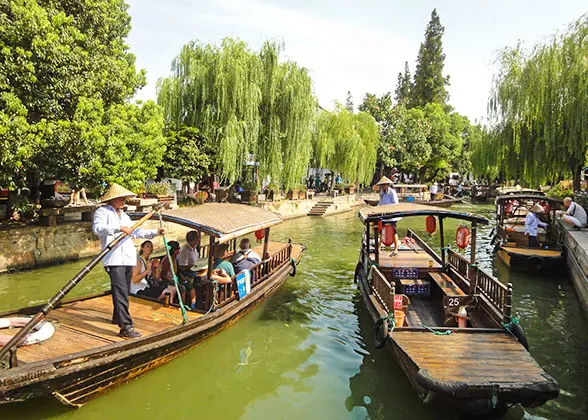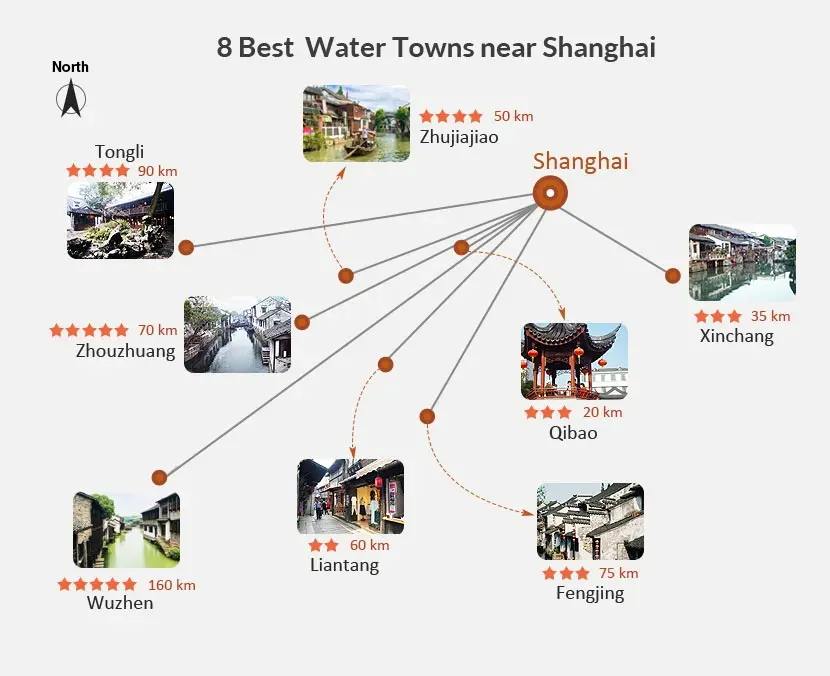Xinchang Ancient Town
Xinchang Ancient Town is an ancient water town which still remains more than 100 folk houses of different sizes in Ming (1368 - 1644 AD) and Qing (1644 - 1911 AD) dynasties. The old streets, the rivers that pass through the town, the exquisite stone arch bridges, and folk houses form a typical picture in China’s Yangtze River Delta.
Xinchang Ancient Town is located in the southeast of Shanghai, about 36 km (22 mi) from the city center, 20 km (12 mi) from Shanghai Pudong International Airport. It was originally a salt field where salt merchants used sea water to make salt. Later, the salt field gradually became a place where salt merchants lived and exchanged goods.
The Historical and Cultural Exhibition Hall was originally a folk house built in Qing Dynasty and has a history of more than 100 years. There are four exhibition areas to introduce the history of Xinchang Water Town, the history of salt field, the celebrities of the town, and the development of the town. This folk house itself has three courtyards from front to the back. There are exquisite carvings on the beams. The eight doors of the main hall are engraved with horses on front and the back is engraved with persons in “Water Margin” which is one of the four great classical novels of China.
The stone archway in Xinchang Ancient Town is magnificent and the stone carvings on it are very exquisite. This stone archway was originally built by a local in Ming Dynasty to praise him, his father and his grandfather who were all high rank officials. After standing there for more than 300 years, it was demolished in 1974. The stone archway that you see now was rebuilt after 1974.
Jiangnan First Teahouse is located in the commercial area of Xinchang Water Town. It was built in the end of Qing (1644 - 1911 AD) Dynasty. It was called Jiangnan First Teahouse because of its unique shape and well-preserved status; Jiangnan refers to regions in the south of the Yangtze River Dealta in Chinese.
It is a three-storey wooden building: the first floor is an ordinary tea house for people to chat and drink tea; the second floor is a bookstore and a nice tea house where folk storytellers often perform. Every time a well-known arrives, listeners from different places gather here. The third floor is where the passengers rest and sleep.
Hongqiao Ancient Street is a folk art street, with folk art gallery, painting workshops, cloth workshops, pottery art shops on both sides. In addition, the “Colorful China, Happy Experience” event is held all year round, when you can enjoy and experience the charm of Chinese folk culture and art, and bring home the folk art works you personally create.
Kind Reminder:
Xinchang Ancient Town is a newly developed ancient town with little commercial compact, therefore, it maintains a natural and original status. And the price of food and beverage is relatively cheap compared with other commercialized ancient towns. If you want to experience the purest rural life in Jiangnan, this is a great choice.
1. Take the metro line 16, and get off at Xinchang Station, go out from exit 2, take the bus line 1068, 628, or Xin-Lu special line and get off at Xinchang Station.
2. Take the metro line 2 or line 7, and get off at Longyang Road Station, go out from exit 2, take the bus line Long-Da special line and get off at Xinchang Station.
3. Take the metro line 16, and get off at Xinchang Station, go out from exit 2, take the bus line 1108 and get off at East Pailou Road Renyi Road Station and walk about 800 meters ( 870 yards) to the west.
 Other Ancient Towns in Shanghai:
Other Ancient Towns in Shanghai:
 Qibao Ancient Town
Qibao Ancient Town
 Fengjing Ancient Town
Fengjing Ancient Town
 Zhujiajiao Water Town
Zhujiajiao Water Town
 A Complete Guide to 15 Shanghai Old Towns
A Complete Guide to 15 Shanghai Old Towns
 Further Reading:
Further Reading:
 Shanghai off the Beaten Path: 8 Lesser-Known Places to Visit
Shanghai off the Beaten Path: 8 Lesser-Known Places to Visit
 5 Things You Must Do in Shanghai in September
5 Things You Must Do in Shanghai in September
Xinchang Ancient Town is located in the southeast of Shanghai, about 36 km (22 mi) from the city center, 20 km (12 mi) from Shanghai Pudong International Airport. It was originally a salt field where salt merchants used sea water to make salt. Later, the salt field gradually became a place where salt merchants lived and exchanged goods.
Recommended Places in Xinchang Ancient Town
Historical and Cultural Exhibition Hall
Stone Archway
Jiangnan First Teahouse
It is a three-storey wooden building: the first floor is an ordinary tea house for people to chat and drink tea; the second floor is a bookstore and a nice tea house where folk storytellers often perform. Every time a well-known arrives, listeners from different places gather here. The third floor is where the passengers rest and sleep.
Hongqiao Ancient Street
Kind Reminder:
Xinchang Ancient Town is a newly developed ancient town with little commercial compact, therefore, it maintains a natural and original status. And the price of food and beverage is relatively cheap compared with other commercialized ancient towns. If you want to experience the purest rural life in Jiangnan, this is a great choice.
How to Reach Xinchang Ancient Town
2. Take the metro line 2 or line 7, and get off at Longyang Road Station, go out from exit 2, take the bus line Long-Da special line and get off at Xinchang Station.
3. Take the metro line 16, and get off at Xinchang Station, go out from exit 2, take the bus line 1108 and get off at East Pailou Road Renyi Road Station and walk about 800 meters ( 870 yards) to the west.
- Last updated on Aug. 13, 2025 by Demi Li -

